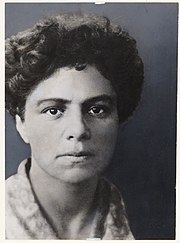Carry van Bruggen's Human Design Chart
2/4 Splenic ProjectorDutch teacher, translator and writer, posthumously acknowledged as an early 1st wave feminist.
Her parents were the orthodox rabbi Izak de Haan (25 September 1839, Edam – 1 May 1924, Amsterdam), who was also a merchant, grocer and religious teacher and his second wife Betje Rubens (20 December 1852, Zutphen – 6 October 1912, Zaandam). The rabbi got 16 children in his two marriages, nine of them died before age of one. Her younger brother Jacob Israël de Haan was born on the last day of the same year in Kloosterveen, now part of Smilde.
Since 1846 Smilde had a synagogue, of which her father was the Hazzan. The village’s economy depended on peat gathering, so the inhabitants were poor. To receive a higher income to support the large family, the family moved in 1882 to Gorredijk and in 1885 to the industrial city Zaandam. Here Lea followed the ULO and the Normaal school, to become a teacher. She held her first job September 1900 in Amsterdam.
On 6 January 1904 she married the man of letters and journalist Cornelis “Kees” Johannes Antonius van Bruggen (14 November 1874, Den Helder – 19 September 1960, Amsterdam) in Amsterdam. The next day they moved to the Dutch Indies and got two children, Bertha en Kees. She wrote book reviews and the women column for the Dutch “Deli” newspaper, of which her husband was the editor. She also wrote short novels in the “Weekblad voor Indië”.
In 1907 the family returned to Amsterdam. She debuted with “In de schaduw” (In the shadow, 1907). Between 1909 (Een badreisje in de tropen) and 1927 (Eva, Eve) some 25 works would follow. Since 1920 (“Uit het leven van een denkende vrouw”, From the live of of a thinking women) she also used the pseudonym Justine Abbing. She taught herself French, German and English and translated work of Sheridan, Shaw, De Musset, Galsworthy, Hugh Walpole and Dumas ino Dutch. Her work was naturalistic, with an eye for the atmosphere, and inspired by her own experiences as a female in a by males dominated world. Unlike the then prevalent male “l’art pour l’art” stream, she clearly wanted to convey a message. In her later work (Heleen, 1913) she more turned inward. The quest for life, why things happen, the search for unity in life, became major themes.
In 1914 she left Kees van Bruggen, they officially divorced on 24 February 1917. She sustained her children with teaching and giving lectures on art and literature. In 1915 she published “Een coquette vrouw” (a coquette women) which had the theme of how to love as a woman, without being being a docile Martha. In 1919 she published the philosophical work “Prometheus”, that explored the development of individualism in literature.
Via her lectures she met the 21 years elder art historian and Amsterdam Rijksmuseum director Adriaan Pit (25 April 1860, Den Haag – 24 November 1944, Nijmegen). They became friends and when he was sick, she cared for him. 20 July 1920 they married. They got no children.
During the first years of the marriage she published “Het huisje aan de sloot” (The cottage at the ditch, 1921) about her youth in Zaandam, “Avontuurtjes” (Adventures, 1922) and “Vierjaargetijden” (Four seasons, 1924). Her last book Eva (Eve, 1927) is seen as her masterpiece.
On 3 April 1928, while giving a lecture, Carry van Bruggen de-compensated and became ill. The physician A. Querido called it a climacteric depression. She struggled four years with the depressive illness and was most upset by her inability to feel. As everything in life was covered by dark shades of grey. On the cold and sunless Wednesday of 16 November 1932 she took an end to her life.
Link to Dutch Wikipedia
Discover More Famous People
Browse and analyze over 55,000 public figures and celebrities.
Ra Uru Hu
5/1 Manifestor
Martha Stewart
4/6 Manifestor
David Lynch
4/6 Generator
Barack Obama
6/2 Projector
Steve Jobs
6/3 Generator
Vladimir Putin
5/1 Manifestor
Kim Kardashian
3/5 Generator
Michael Jackson
1/3 Projector
Marilyn Monroe
6/2 Projector
Ariana Grande
2/4 Projector
Oprah Winfrey
2/4 Generator
Johnny Depp
2/4 ManifestorWhat is HumanDesign.ai and how does it work?
Curious what makes Carry van Bruggen tick? HumanDesign.ai instantly maps their exact birth data into a fully interactive clickable bodygraph chart, letting you hover or tap every center, channel, and gate for plain-language explanations. Bella, the platform’s built-in AI guide, adds context in real time, translating complex mechanics into everyday insights so you can see how Carry van Bruggen’s strengths, challenges, and life themes play out on-screen.
The same tools are waiting for you. Generate your own Human Design Chart in seconds, open a library of 2000+ suggested questions, and chat with Bella as often as you like to decode your design, daily transits, and even relationship dynamics.
Want to compare energies? Save unlimited charts for friends, family, or clients, then ask Bella to reveal compatibilities, composite patterns, or coaching tips, all in one conversation thread.
Start free with core features, or unlock our Personal and Pro plans for deeper dives: unlimited Q&A, celebrity chart search spanning 55,000+ public figures, white-label PDF reports, branded content generation, and a professional profile with built-in booking for practitioners. Whether you’re exploring your own potential or guiding others, HumanDesign.ai delivers an ever-expanding toolbox of AI-powered insights—no spreadsheets, no jargon, just clarity at your fingertips.
Ready to see yours? Signup for FREE today!

